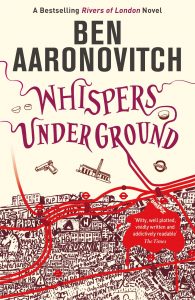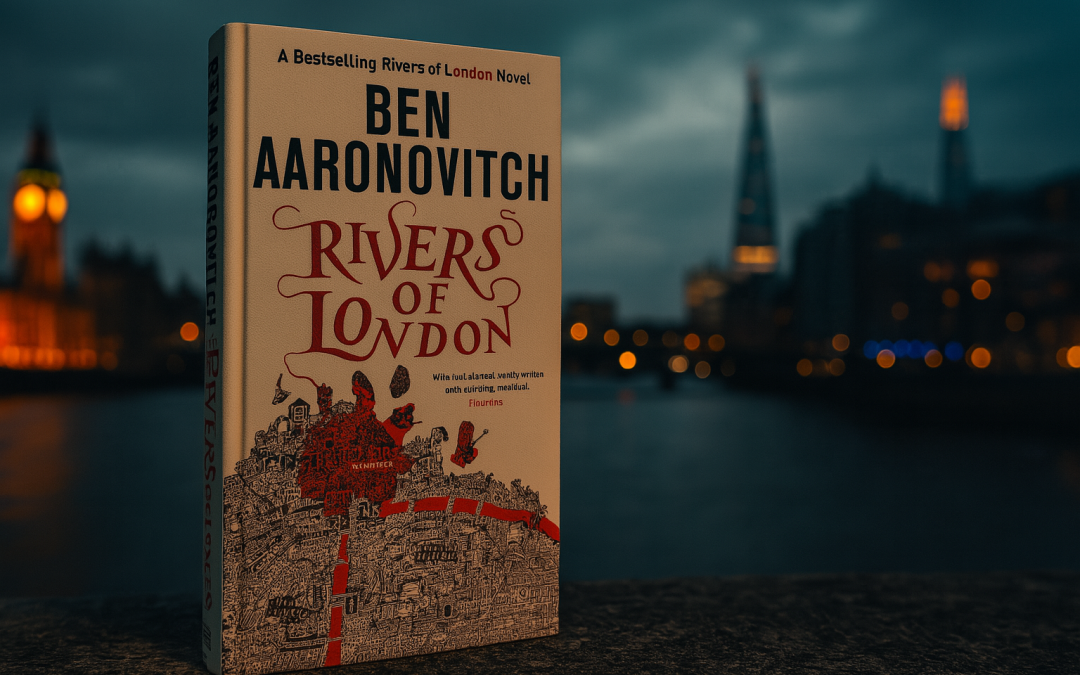Ben Aaronovitch’s Rivers of London series fuses the pace of police procedurals with the imaginative power of urban fantasy, creating a version of London shaped by magic, memory, and myth. From the first novel, readers are introduced to a city where magic doesn’t exist in a parallel world. Instead, it threads itself through rivers, alleyways, and bureaucratic systems. London remains recognisable, but it hums with invisible energies—ones Peter Grant must learn to perceive and interpret.
Rather than whisking readers away to a fantastical realm, Aaronovitch anchors magic in the ordinary. Peter isn’t a chosen one or ancient bloodline heir; he’s a mixed-race probationary officer who stumbles into magic and begins to read the city anew. As his awareness grows, so does our understanding of London as a layered and contested space. The fantastic does not escape reality—it confronts it, challenging how power, memory, and identity function in urban life.
Gods and Class Power in Rivers of London
Among the series’ most powerful metaphors are the river gods and goddesses. These figures do more than personify water—they reveal the political geography of London. Mother Thames is no ethereal spirit. She’s a Nigerian matriarch enthroned in East London, surrounded by mangrove roots and sea-salt air. Her power radiates through sensory detail—smells of fish guts and diesel, heat rising from her ritual space. Her domain draws on the histories of migrant communities, placing her at the heart of London’s multicultural reality.
Her counterpart, Father Thames, rules the upstream territory from a fairground near the river’s source. He’s all faded Englishness—tweed suits, brass bands, and nostalgia. His refusal to venture past Teddington Lock reflects a retreat from the complexity of the modern city. These two figures embody a deeper metaphor: the division between rural memory and urban diversity. Their clash stages a symbolic battle over what London is and who it belongs to.
Lady Tyburn and Fleet, goddesses of buried rivers, carry the metaphor further. Tyburn, cloaked in elite networks and understated gestures, rules from a polished West End flat. Her influence is quiet but absolute, mirroring the social capital of Britain’s upper class. Fleet, practical and direct, operates from North London, representing institutional power and civil order. These river spirits map the structures of privilege that shape the city’s flow—not just its water, but its politics.
Jazz Clubs and Cultural Memory in Moon Over Soho
 In Moon Over Soho, Aaronovitch shifts from rivers to music venues. Soho’s jazz clubs are not mere backdrops—they pulse with emotional residue. Peter, through his ability to sense “vestigia,” reads the city’s past as it clings to physical spaces. Clubs like The Spice of Life echo with sound, sweat, and forgotten performances. They are cultural palimpsests where memory surfaces in sound, smell, and emotion.
In Moon Over Soho, Aaronovitch shifts from rivers to music venues. Soho’s jazz clubs are not mere backdrops—they pulse with emotional residue. Peter, through his ability to sense “vestigia,” reads the city’s past as it clings to physical spaces. Clubs like The Spice of Life echo with sound, sweat, and forgotten performances. They are cultural palimpsests where memory surfaces in sound, smell, and emotion.
The Mysterioso, another venue, plays with layers of authenticity and artifice. It feels theatrical, even fake, until bursts of real memory disrupt the illusion. These aren’t just nostalgic sites—they expose how the city markets its culture while obscuring its emotional cost. Meanwhile, the Café de Paris, haunted by the Blitz, erupts with trauma. Here, memory is raw and uncurated. These clubs map London not through roads, but through rhythm—through what lingers in the air long after the music stops.
Jazz vampires emerge as an unsettling metaphor. Feeding on musical energy, they embody the commodification of culture. Artists in this world are drained of vitality, celebrated while being consumed. The vampires’ origin—rooted in wartime trauma—connects performance, exploitation, and grief. Unlike Dracula, they don’t dominate. They linger. They are symptoms of a city that consumes memory and recycles it as product.
The Quiet People and Forgotten Labour in Whispers Under Ground
 Whispers Underground turns to what lies beneath the city. Here, we meet the Quiet People, a subterranean community descended from brickmakers and forgotten labourers. Living beneath Notting Hill, they represent the histories cities try to bury—working-class survival, erased industry, the cost of gentrification. Their presence disrupts the fantasy of progress. Above them rise luxury flats; below, pigs and refinery fires keep a hidden economy running.
Whispers Underground turns to what lies beneath the city. Here, we meet the Quiet People, a subterranean community descended from brickmakers and forgotten labourers. Living beneath Notting Hill, they represent the histories cities try to bury—working-class survival, erased industry, the cost of gentrification. Their presence disrupts the fantasy of progress. Above them rise luxury flats; below, pigs and refinery fires keep a hidden economy running.
These people don’t live in a magical underworld separate from reality. They are London. They are its backbone, its buried infrastructure. Aaronovitch draws on spatial metaphors—up is visibility and privilege, down is marginality. But here, down is also survival, ingenuity, resistance. The Quiet People reveal that what seems erased is often foundational. Their existence reminds us that the city’s present rests on the labour of those no longer visible.
Their world challenges modernity’s narrative. They resist integration, defy categorisation, and expose how easily cities forget what they still depend on. These aren’t villains or rebels—they are what remains. They are the unfinished business of urban history, made literal through fantasy.
London as a Haunted Stage
Across the series, Aaronovitch presents London as a stage—one where performances of power, identity, and memory play out daily. The Royal Opera House scene captures this metaphor perfectly. A place of elite spectacle becomes a battleground where magic, history, and politics collide. The curtains may rise on glamour, but behind them lies the machinery of exclusion.
Peter Grant, navigating both magical and institutional worlds, is not the city’s hero in the traditional sense. He’s a stage manager—holding it all together, translating one system into another, making sure the show continues. Opposite him stands Mr Punch, a figure of uncontained chaos. He doesn’t just represent evil. He mocks the entire performance, thriving on slapstick violence and the erasure of meaning.
Aaronovitch’s London is not unified or easily mapped. It is fragmented, contradictory, and layered with unresolved histories. Magic doesn’t fix this; it makes it visible. Through Peter’s journey, we glimpse a city struggling to reconcile who it was, who it is, and who it’s becoming.
Urban fantasy, in Rivers of London, becomes more than escapism. It’s a lens for reading the invisible rules of the real world—for uncovering how cities remember, forget, and try to hold themselves together.

D.P. Martinez is a contemporary fantasy author specialising in urban fantasy and magical realism. He holds an M.A. in English Literature from the University of Greenwich, where he focused on Literary London. His research explored metaphorical representations of London in urban fantasy. He has written hundreds of articles and several books across both fiction and non-fiction.

